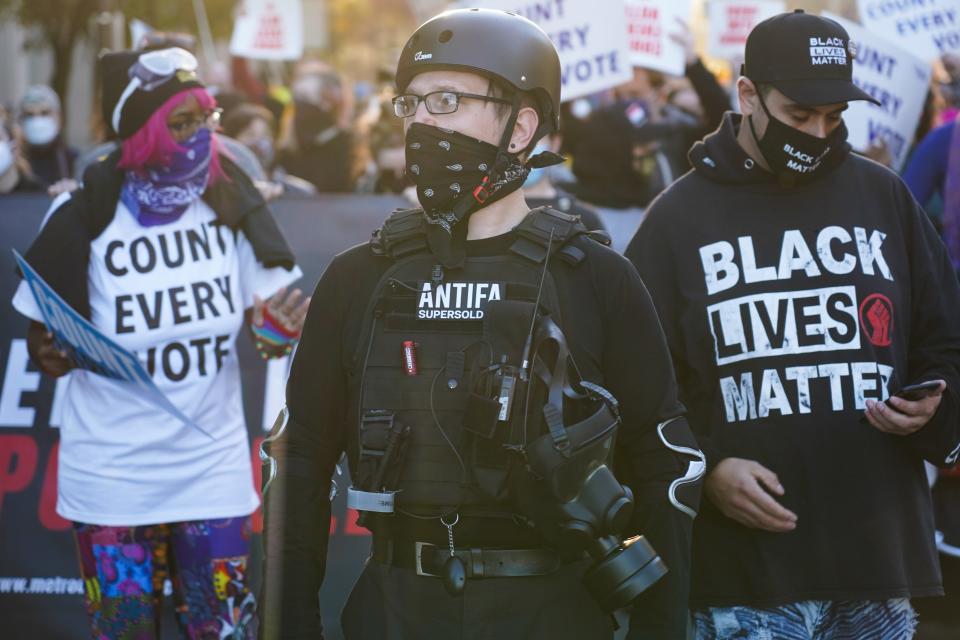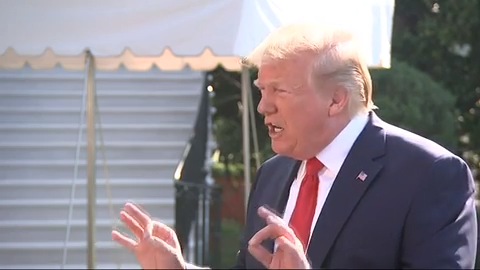Where's Antifa been this year? Anti-fascist groups stepped away from street protests, not activism
- Oops!Something went wrong.Please try again later.
A year ago, conservative pundits couldn’t air enough breathy reports about Antifa. Tucker Carlson, Ben Shapiro and Alex Jones warned of a veritable anarchist army ready to overthrow the U.S. government and impose a communist regime. It didn't.
After hordes of supporters of former President Donald Trump invaded the U.S. Capitol on Jan. 6, Antifa was nowhere to be seen. Two weeks later, when Joe Biden was inaugurated as president, experts warned far-right activists might descend on Washington again.
For the rest of the year, apart from a few isolated scuffles, Antifa activists haven’t engaged in the street battles or civil unrest that marked the preceding years.
As 2021 comes to a close, a question looms: What happened to Antifa?
This lack of highly public engagement by anti-fascists doesn’t mean the movement has gone away. Antifa experts and self-proclaimed anti-fascists said activists do what they have always done: quietly research and expose racists, bigots and other people who mean harm to their fellow Americans and work on community projects that support marginalized people.
“In the broad spectrum of activities that are effective in anti-fascism, most go completely unnoticed compared to street action, which is really just the tip of the spear,” said Chad Loder, an anti-fascist activist in Southern California. “That’s really just an activity of last resort for Antifa.”
Because many people define Antifa only by the actions of a minority of activists, rather than recognizing the entirety of the movement, they miss the whole picture, said Stanislav Vysotsky, a professor of criminology and author of the book "American Antifa."
“The street demonstrator is such a small portion of what anti-fascist activism entails that it's very much blown out of proportion," Vysotsky said. “Ninety-five percent of anti-fascist activism is nonconfrontational and nonviolent.”
Proud Boys Recruitment: They joined the Wisconsin Proud Boys looking for brotherhood. They found racism, bullying and antisemitism.
Antifa on Jan. 6: Misleading claim about 'antifa member' at Capitol riot

Antifa: The liberal bogeyman
The stereotypical image of an Antifa activist is a violent one: a young person, all in black, wearing menacing lace-up boots and a face mask and probably holding a weapon of some sort.
This enduring boogeyman image is by design.
Ever since the term Antifa came into common use in 2017, the American far-right, aided by pundits in conservative media, has seized upon it, casting it wherever there is civil disobedience or anarchy. Crowds that turned angry, from Black Lives Matter protesters to environmental activists to student protesters, have been labeled Antifa by conservative commentators.
It’s a political tactic, said Mark Bray, a lecturer in history at Rutgers University and author of “Antifa: The Anti-Fascist Handbook."
“They care about using that specter to associate Antifa with the Democratic Party; in order to portray the Democratic Party as extremist, fanatical, violent and anti-democratic,” he said. “That's the real payoff in that rhetoric.”
The reality is that most anti-fascist work is more mundane, Bray and other experts said. Most anti-fascists spend more time in front of their keyboards or attending cultural events than they do on the streets confronting the far-right or engaging in civil disobedience.
“What these groups are doing is a lot more about research into what far-right groups are active, who their members and leaders are, where they're trying to have events,” Bray said. “The kinds of public spectacle, confrontation, was always, at most, the tip of the iceberg of what these groups do.”
Antifa rises, then goes underground
The anti-fascist movement, active in Europe since the dawn of fascism in 1920s Italy, came to the USA in the mid-1980s.
As the American racist skinhead movement flourished, anti-racist groups began organizing, some coalescing into formal collectives such as Anti-Racist Action in Minneapolis. These groups confronted racist skinheads, sometimes violently, at concerts and demonstrations.
As the skinhead movement died down in the late-’90s, anti-fascism went largely underground. Since there were fewer overt, organized racist groups on America’s streets, anti-fascists resumed their work researching the far-right and naming and shaming people with hateful views, a tactic that became known as “doxxing.”

Antifa reemerges to fight growing racism
The election of Donald Trump as president and the ensuing reemergence of the racist far-right in America sent shock waves through the anti-fascist movement.
Here was a president who had started his political career with the trope that former President Barack Obama was not a U.S. citizen. He called Mexican immigrants “rapists” and was accused of supporting racist causes.
White supremacist America saw its opportunity.
“In the craziness of the 2016 Trump era, I was euphoric,” said Richard Spencer, the de facto leader of the “alt-right,” a political movement that mixes racism, white nationalism, antisemitism and populism. “It felt like it could just keep going, we could just fly.”
As they had in the past, anti-fascists watched as white supremacists became emboldened. Veteran anti-fascist activists were quickly joined by legions of volunteers who wanted to help stem what they called a fascist tide washing across the country.
"With Trump, there were a lot of people that were concerned about the threat of fascism," said Kieran Knutson, a longtime Minnesota activist who was a nonracist skinhead and a founding member of Anti-Racist Action in 1987. "There was a genuine influx of people who considered themselves anti-fascists and wanted to do something."
At a rally called Unite the Right in August 2017 in Charlottesville, Virginia, young white supremacists marched through a university campus bearing torches and chanting, “Jews will not replace us.” They were met by scores of counterprotesters, many of whom self-identified as anti-fascists. Heather Heyer, 32, was killed when a man who had espoused neo-Nazi beliefs drove his car into a crowd of counterprotesters.
Charlottesville introduced many Americans not just to an emergent racist right but also to an invigorated anti-fascist movement whose members were willing to get bloody fighting for a cause they believed in, Vysotsky said. Charlottesville also spawned a mythology about the movement that would, for many Americans, define it for years to come, he said.
“That particular day is so marked by violence and confrontation, and that was the moment that people were first exposed to Antifa,” Vysotsky said. “So they remember it that way.”
The bogeyman label sticks
Charlottesville was followed by street clashes in Berkeley, California, Portland, Oregon, and other cities. Trump and his allies focused on the boogeyman of Antifa.
The image of Antifa as radical anarchists bent on political violence became a rallying cry for the far-right. The Proud Boys and the armed, unauthorized militia the Oath Keepers, extremist groups linked to white supremacists, had a tangible target for their hatred: the black-clad protesters who met them at every turn.
In the widespread protests after the murder of George Floyd and the killing of Breonna Taylor in 2020, demonstrators adopted tactics that had been used by anti-fascist activists for decades.
By dressing all in black and using “black bloc” formations in which protesters cover their faces and are hostile to anybody taking their photograph, they looked just like the anti-fascists who had been showing up for years. Much of the news media identified them as such, simply attaching the “Antifa” label wherever young people showed up wearing black clothes, Bray said.
“I was saying on repeat during 2020, when President Trump was blaming all of the property destruction during the George Floyd protests on Antifa, that there are not as many groups in this country, nor is their membership nearly numerous enough to have been responsible for all of that,” he said. "Antifa is a fraction of the radical left – a small fraction."

Antifa goes to ground
Even before the Capitol riot Jan. 6 and the hundreds of federal investigations, arrests and indictments that resulted, the far-right in the USA was waning.
In spring 2018, Spencer told his followers that Antifa was “winning” the culture wars. By 2020, far-right rallies were met with such a massive show of force by counterprotesters that they required heavy police protection.
Then came the insurrection Jan. 6 by extremist Trump supporters, the fallout from which may have taken more wind out of the far-right movement. Rallies in 2021 have been embarrassing spectacles for their organizers, and Antifa activists haven't taken the bait, leaving them to fizzle on their own.
Anti-fascists got back to their day jobs, including researching and outing racists and members of hate groups. Instead of street confrontations, anti-fascists post links on social media exposing neo-Nazis and other white supremacists.
The absence of widespread Antifa activity in public this year has largely been in response to the chastening of the far-right. The far-right haven't held big rallies, so the anti-fascists haven’t seen the need to respond.
Far from the radical claims by cable news anchors and far-right pundits, the Antifa movement has not sought a communist takeover of the country. Nor have anti-fascists engaged in widespread civil disobedience or conducted mass shootings or invaded the U.S. Capitol. Antifa spent 2021 doing the work it has always done.
"That’s the thing about anti-fascism," Knutson said. "If there isn’t a visible fascist movement, people find other things to do."
This article originally appeared on USA TODAY: Antifa groups stepped away from street protests, not activism in 2021

